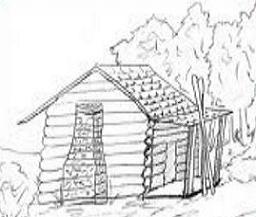Charles G.
Andruss


Sallie Charlota
Andruss, daughter of Charles G. Andruss, had
three brothers - Albert, Henry, and Luther.
Her 1933 obituary is the only
documentation at this time of her family
living in the first house in Denison, "a log
cabin deserted by Indians".(See note below on this
page.) The 1900 census gives
Sallie's death as June 1869, and she would
have been two years old in 1871 or 1872.
The first lots in Denison were sold in
September 1872 and Denison was incorporated
in March 1873.
Another claim
is that Dr. Alexander Morrison occupied the
first house on the present area of Denison -
a one-room log cabin. (The Denison
Herald, September 23, 1962)
Charles G.
Andruss operated a grocery in Denison in
1878 (The
Daily News, Thursday, March 30,
1876, pg.3)
The Andruss chlldren received their
education in the Denison schools. In
August 1877 a list of students in Denison's
graded schools was printed listing the names
of the students, the grade to which they had
been promoted, and the rooms they were to
occupy:
2nd grade - M. Andruss, L. Andruss
4th grade - H. Andruss
6th grade - Jessie Andruss
The children were notably mentioned as young
people in the social news of Denison.
In August 1890 Sallie made
preparations to attend school in Boston.
The Sunday
Gazetteer
Sunday, August 31, 1890
pg. 4
Miss Sallie Andruss will leave next Saturday
for Boston, Massachusetts, to attend the New
England conservatory of music during the
ensuing term.
Miss Inez Brown will leave next Saturday for
Boston, where she will enter the New England
Conservatory of music on September 11, for a
teacher's course. She will be
accompanied by Miss Sallie Andruss, of this
city, and a young lady friend from
Jefferson, Texas.
Mr. Andruss died
Monday, March 30, 1891, just three days
after Dr. Alexander Morrison, at his home on
Woodard Street. (The Sunday
Gazetteer, April 12, 1891, pg.3)
He is buried at Fairview Cemetery alongside his
wife and two sons. In December of the
same year, Albert S. Andruss, died and was
buried alongside his father.
In October 1892 Sallie married G.W. Smith at
her home on West Woodard in Denison; they
made their home in Tyler where the
bridegroom was employed by the I. & T.N.
railroad (International & Great Northern
Railroad). Just short of a
year later, their son, Henry, died and was
buried next to his parents.
G.W. Smith, husband of Sallie, died
at the age of 58 in Denison; his obituary
implies that he worked 40 years for the
Katy railroad and 38 of those years. years
were "consecutive", 1882 - 1920.
In
September 1909 Luther Andruss and family
moved to Florida. (The Sunday
Gazetteer, Sunday, Sept 26, 1909,
pg. 4).
(note; The Indian cabin
is highly unlikely, The Indians lived in
the Indian Nations, no longer did any
pass through hunting, that ended in the
1830's. The few cabins that still were
around at that time were left over from
people migrating into Texas in the
1840's and where they had to wait till
they got their land allotments in Texas
or had to wait till the winter rains
passed so the roads could be traveled
with wagons.
The left over shacks and cabins from
that time were usually taken apart and
reused as outbuildings, or foundation
logs or became occupied with Freedmen
who scrambled for any shelter after they
were freed in 1865. No one wasted much.
(though we have records of a few outlaw
cabins in NW Grayson, people were afraid
to go there. The outlaws just took what
they wanted. The citizens burned them if
they were near to remove the criminal
hideouts)
Lumber by the way was readily available
in the 1850-1860s; It came from the
Choctaw Nation across the river, and
they had hardware available also up
there. The 'Pioneer' cabin building was
over by the second half of the 1850's.
It was in the late 1840's that wagon
trains came from Jefferson, TX carrying
shingles and lumber. Many who stayed in
a log home they had built, took that new
siding lumber and sheathed the cabin
they were staying in and built on to it.
Many times people tearing down old
houses find a cabin or a portion of its
foundation as a room of the house.
Denison was a tent city in mid-winter
when the first train came through. Many
people who had the means left the women
and children elsewhere, like Sherman in
hotels or 'back home')
|

